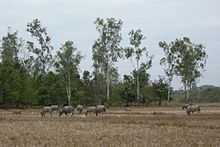Cát Tiên National Park

Cát Tiên National Park (Vietnamese: Vườn quốc gia Cát Tiên) is an important national park located in the south of Vietnam, approximately 150 km north of Ho Chi Minh City. It has an area of about 720 km2 and protects one of the largest areas of lowland tropical rainforests left in Vietnam.
History
Cát Tiên national park was protected initially in 1978 as two sectors, Nam Cat Tien and Tay Cat Tien. Another sector, Cat Loc, was gazetted as a rhinoceros reserve in 1992 upon the discovery of a population of the Vietnamese Javan rhinoceros, an occasion that brought the park into the world's eye. The three areas were combined to form one park in 1998.
The park suffered historically during the Vietnam War when it was extensively sprayed with herbicides like the defoliant Agent Orange; however, further damage was done by logging up until the 1980s. To this day these areas have extensive bamboo and grassland cover and trees have not yet grown back.
Archaeology
Biodiversity
Cát Tiên National Park consists of evergreen tropical and deciduous forest, dominated by Dipterocarpaceae, Fabaceae and Lythraceae (especially Lagerstroemia spp.), with 40% of the park comprising bamboo woodland, and the remaining 10% farmland, wetlands and grassland.
Mammals
The park fauna included the Javan rhinoceros, and was one of only two populations in the world, until poachers shot and killed the last rhino in Cát Loc in 2010. Asian elephants, sun bears and gaur still persist in the area, whereas banteng, kouprey (may be globally extinct), and wild Asian water buffalo no longer occur in Cat Tien.[1] Some accounts also list Indochinese tigers, leopards, clouded leopards, dholes and Asiatic black bears. However, a recent series of surveys did not confirm this. The park also hosts many smaller mammal species, including yellow-cheeked gibbons, black-shanked douc langurs, crab-eating macaques, pygmy slow loris, as well as civets, mouse deer, and treeshrews.
Birds
The park also has impressive bird species including:
- Red junglefowl
- Green peafowl
- Siamese firebacks (although found elsewhere, these are especially easy to see in the park)
- Germain's peacock-pheasant
- Orange-necked partridge
- Great, Oriental pied and the wreathed hornbills
- Bar-bellied, blue rumped, blue winged pittas
- Broadbills: including the black and red, dusky and banded species
- Endemic sub-species of the red-vented barbet
- Grey-faced tit babbler
- Woodpeckers: including pale-headed, white-bellied, black-and-buff, heart-spotted and the great slaty woodpecker
- Lesser adjutant birds, various herons and egret species
- Milky stork and the woolly-necked stork has also been reported in recent years
- a wide variety of resident and migratory waterfowl; although recorded, white-winged ducks may no longer be present in the park
- birds of prey including osprey, lesser fish eagle, grey-headed fish eagle, crested serpent eagle, collared and other falconets.
Threats
Cat Tien comprises an important reserve in Vietnam, both for the habitat it protects and the number of species it contains. Although the population of the Javan rhinoceros went into extinction, it is still home to 40 IUCN Red List species, and protects around 30% of Vietnam's species. The park is, however, threatened by encroachment from local communities, illegal logging and poaching. In addition, the park is too small for the larger species found inside it. This has led to either their local extinction or conflict with local people as these animals move beyond the confines of the park. This problem is particularly intense for the park's elephant population, which is prone to wandering and is considered too small to be self sustainable.
Since the early 1990s, partly as a result of the discovery of rhinos in the park, international donors and the Vietnamese government began to invest more money in protecting the park and managing the resources of local State Forest Enterprises, nearby and adjoining forests (including Vinh Cuu Nature Reserve), in co-ordination with the park as a whole. There have been moves to combine a management plan that allows for both traditional park management and some limited resource utilisation by local people, which include the Stieng, Chau Ma (now concentrated in Ta Lai) and Cho'ro minorities.
In 2008 the Forestry Protection Department collaborating with the Endangered Asian Species Trust (UK), Monkey World Ape Rescue(UK) and Pingtung Wildlife Rescue Centre (Taiwan) founded the Dao Tien Endangered Primate Species Centre. The centre focusses on the rescue, rehabilitation and release of the four endangered primates found in Cat Tien (golden-cheeked gibbon, black-shanked douc, pygmy loris and silvered langur), developing Government guidelines for release of primates. The centre conducts informative daily educational tours explaining the centre's work, with a chance to see young rehabilitated gibbons in the trees.
| Wikimedia Commons has media related to Cat Tien National Park. |
References
- ↑ Nguyen, M., H., (2009). The status of Vulnerable gaur Bos gaurus and endangered banteng Bos javanicus in Ea So Nature Reserve and Yok Don and Cat Tien National Parks, Vietnam. Oryx 43 (1), 129-135.
Protecting mammal diversity: opportunities and constraints for pragmatic conservation management in Cat Tien National Park, Vietnam, Oryx, 38, Polet & Ling, (2004)
External links
 Cat Tien National Park travel guide from Wikivoyage
Cat Tien National Park travel guide from Wikivoyage- Cat Tien National Park: further information including species lists
- Video: Cat Tien National Park in Vietnam
- Gibbon rehabilitation at Cat Tien
- WWF in Cat Tien
- Wildlife rescue centre based in HCMC - helps fund moon bear project in Cat Tien National Park.